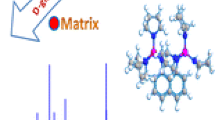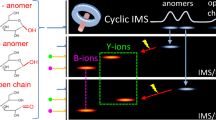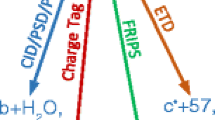Abstract
Proof of concept evidence is presented for a new method for the determination of isoaspartate, an important post-translational modification. Chemical derivatization is performed using common reagents for the modification of carboxylic acids and shown to yield suitable diagnostic information with regard to isomerization at the aspartate residue. The diagnostic gas phase chemistry is probed by collision-induced dissociation mass spectrometry, on the timescale of the MS experiment and semi-quantitative calibration of the percentage of isoaspartate in a peptide sample is demonstrated.

ᅟ
Similar content being viewed by others
Avoid common mistakes on your manuscript.
Introduction
In vitro and in vivo isomerization of aspartate (Asp) to isoaspartate (isoAsp) is a common post-translational modification. Deamidation of asparagine (Asn) can also yield isoAsp via a common succinimide intermediate. Not only can these transformations change the structure and activity of a protein, but they can also lead to changes in immunological response. Furthermore, an increase in endogenous isoAsp has been linked to Alzheimer’s disease [1]. The body naturally produces enzymes that work to reduce the levels of isoAsp, namely protein isoaspartyl methyl transferase/L-isoaspartyl protein carboxyl methyl transferase (PIMT/PCMT), both of which methylate isoAsp to promote isomerization to Asp [2] and produce intermediates which can be trapped to produce modified peptides which can be distinguished by mass spectrometry [3, 4].
This PTM is also a concern to the biopharmaceutical industry [4], where shelf-life and activity may be directly affected. In fact, isoAsp generation is one of the most common contributors to heterogeneity in protein-based drugs. Factors which induce the generation of isoAsp include pH, secondary and tertiary protein structure, and method of formulation.
Biopharmaceutical analysis in general is often reliant on mass spectrometry. Typically, mass spectrometry is coupled to chromatography to facilitate analysis of pure or nearly pure components. HPLC has been used to separate Asp/isoAsp-containing peptides; the success of this method largely relies on changes in the secondary structures of medium-large peptides associated with isomerization [5].
Other methods for the detection of isoAsp vary in complexity [6, 7]. An enzymatic, fluorescence-based assay has recently been reported by Puri et al. [8]; it has a significant time requirement. Mass spectrometric methods are among the most widely reported. Specifically, these methods include electron transfer dissociation (ETD), electron capture dissociation (ECD), and 18O labeling. ETD [9] and ECD yield specific fragment ions for isoAsp, facilitating detection. Methods of 18O labeling [4] involve the selective enzymatic conversion of isoAsp to the succinimide intermediate, followed by hydrolysis with H218O.
Recently, matrix-assisted laser desorption/ionization mass spectrometry (MALDI-MS) has been utilized to differentiate beta amino acid-containing peptides. Utilizing in-source decay, Yu et al. were able to observe specific reaction and subsequent fragmentation of Asp/isoAsp with 1,5-diaminonaphthalene (1,5-DAN) [10]. This method yielded similar fragmentation to that of ETD. High resolution ion mobility has also recently been documented as a technique for the determination of aspartate and isoaspartate. The results from this technique are apparently excellent, but the equipment is still not widely available [11].
One of the oldest questions in tandem mass spectrometry is whether an ion undergoes a specific rearrangement before dissociation. McLafferty in 1959 reported the best-known version of this paradigm with the (subsequently) eponymous McLafferty rearrangement [12]. That example permitted the determination of the structural arrangements of functional groups in particular ions. Rearrangements, if non-specific, can also be detrimental [12], for example deuterium scrambling can convolute isotope dilution experiments or the interpretation of fragmentation pathways. Some of the more important rearrangements arise from fragmentation of intermediates known as ion-neutral complexes [13], typically proton-bound heterodimers of the incipient cation and a neutral fragment. It has been demonstrated that unusual fragmentations can occur from these species due to the formation of an orbiting complex before dissociation.
This study utilizes typical carboxylic acid coupling reagents, namely carbodiimides, and the rearrangement of the products of binding with carboxylate residues. The bonding of a carbodiimide to a carboxylate functional group within a peptide produces acylisourea (AiU). AiU can rearrange to N-acylurea (NAU) via 1,3-acyl shift.
Experimental
1-Ethyl-3-(3-dimethylaminopropyl)carbodiimide hydrochloride (EDC) and dicyclohexylcarbodiimide (DCC) and phenylhydrazine were acquired from Sigma-Aldrich (St. Louis, MO) and used as received. Ethanol was acquired from Makron Fine Chemicals LTD (Center Valley, PA). The peptide samples were purchased from Anaspec Inc. (Fremont, CA) and used as received. Nanoelectrospray emitters (tip size < 5 μm) were prepared using a micropipette tip puller (Sutter instruments, Novato, CA). A voltage of 1.5 kV was applied to the solution in the emitters to generate ions. Analysis was conducted on a standard linear ion trap (LTQ, Thermo Scientific, San Jose CA) or an Orbitrap (LTQ-Orbitrap XL, Thermo Scientific, San Jose, CA) instrument.
A stock solution of carbodiimide was prepared in (10 mM in 1:1 EtOH:H2O). A sample of the peptide was prepared (1 mM in 1:1 EtOH:H2O). Standard solutions for analysis by nanoelectrospray were prepared which contained both the peptide (500 μm, 1 eq.) and the carbodiimide (1 mM, 2 eq.). Analysis was conducted by loading a 10-μl sample into a nanoelectrospray emitter and then applying a potential of 1.5 kV.
The instrumental parameters for standard collision-induced dissociation (CID) analysis were as follows: capillary voltage; 15 V, tube lens; 65 V, capillary temperature; 150 °C, maximum ion injection time; 10 ms, isolation width; 5 units, collision energy; and 25 arb. It should be noted that these conditions are not necessarily suitable for every case/every instrument. The parameters with the most influence on the mass spectrum are ion injection time and ion isolation width.
Results and Discussion
Some groups have studied the rearrangement of AiU to NAU for synthetic purposes, while others have studied it, because it interferes with intended coupling reactions afforded by the AiU species, which is active to nucleophilic attack [14,15,16,17,18,19,20,21,22,23]. The fragmentation of protonated AiU and NAU in the mass spectrometer is different and so they can be distinguished by a CID product ion scan despite the fact that they are isobaric. Scheme 1 illustrates the binding of carbodiimide to aspartate, rearrangement of that species, and the fragmentation pathways taken by each.
Figure 1 shows the CID product ion mass spectra of the pentapeptides ALDGK and ALDisoGK (where Diso is isoaspartate) bound to EDC. Further examples of EDC-bound peptides can be found in SI, section 1. Of particular interest is the difference in the abundance of the fragments of NAU and AiU, which is the metric reported here for the determination of isoAsp.
It is possible that the carbodiimide may bind the C-terminus of the peptide in spite of the presence of the aspartate residue. If this were the case, there would be little reason to expect differentiation between peptides differing only in isomerism at the aspartate residue, so an experiment was conducted to reveal the binding site of the diimide.
As previously discussed, AiU is active towards nucleophilic attack. By adding phenylhydrazine to the bulk solution, it was possible to form the hydrazine amide which could be fragmented to determine the position of diimide derivatization. Figure 2 shows the CID product ion mass spectrum of the amide produced from reaction of AiU with phenylhydrazine. Labeled in red are the fragment ion signals which prove that the aspartate was derivatized, as they are all fragments from the C-terminus where the remaining ion retains the phenylhydrazine moiety.
Having established that successful derivatization of the aspartate residue was occurring, we set out to determine if the rearrangement from AiU to NAU was occurring in the gas or solution phase, and to what extent it could be controlled. It was observed that by changing the energy deposition into the ions before the fragmentation event, the product ion mass spectra could be manipulated to exhibit more NAU. This was initially observed serendipitously, as a function of the isolation width utilized in the CID experiment. The narrower the isolation width, the greater the level of conversion from AiU to NAU in the ion trap.
This observation was equated with energy input. In order to isolate a single m/z value in the ion trap, a high bandwidth AC frequency which contains all of the characteristic frequencies of ions at higher and lower m/z, excluding the characteristic frequency of the ion to be isolated is applied to the electrodes. This effectively energizes those ions which are not Mof interest to the point that they are removed from the ion trap by, typically, crashing into the electrodes.
Even though the characteristic frequency of the ion to be isolated is not directly applied to the trap, a single m/z value does not resonate with a single frequency but, rather, a narrow bandwidth of frequencies [21]. It is therefore easy to impart at least a little energy into the isolated ion, especially if the isolation width is narrow. The energy which is deposited is low, and so does not induce fragmentation of the ions under study here; it seems simply to promote the rearrangement of ions from AiU to NAU. This is illustrated in Fig. 3a, b, which shows the fragmentation spectra of ALDisoGK-EDC using a narrow and wide isolation window, respectively.
It was also found that the ratio of ions in the mass spectrum could be directly affected by changing the injection time (effectively the residence time) of ions into the trap. If the ions were given a longer residence time, the spectrum was dominated by the fragment of NAU and vice versa (Fig. 3c, d). The ability to manipulate the ions (and therefore the spectra) in this way highlights that the discriminatory ion ratio is born of a dynamic, gas-phase process which occurs on the time of the mass spectrometry experiment (milliseconds).
There still remains the question of why the rearrangement occurs to different extents for Asp and isoAsp in the first place. It is asserted that the discrimination is due to the different steric demands of each residue. Scheme 2 illustrates this concept and demonstrates that, sterically, it is reasonable to assume that there would be a higher barrier to rearrangement in the case of an isoAsp-bearing peptide, which matches the recorded trends for a range of peptide pairs differentiated by the presence of Asp or isoAsp (Table 1).
In order to probe the importance of sterics, another more sterically demanding diimide was tested. DCC, by virtue of the cyclohexyl substituents, is bulkier than EDC. Presented in Fig. 4 are the Product ion CID mass spectra of ALDGK-DCC and ALDisoGK-DCC.
The use of DCC, to a large extent, hindered the rearrangement such that the AiU species was dominant in both the spectrum of ALDGK-DCC and ALDisoGK-DCC. Rearrangement to NAU was still recorded to a greater extent for the aspartate residue, but clearly rearrangement is hindered.
Utilizing EDC and constant conditions, it was possible to produce semi-quantitative calibration curves for the determination of isoAsp in the backbone of peptides. Presented in Fig. 5 is a calibration of isoAsp as a percentage of Asp in the backbone of ALD(iso)GK. Further examples are given in SI (section 2).
Peptide maps typically contain peptides of five or six residues in length, suggesting that the range of peptides tested in this manuscript establishes the utility of the chemistry. The method apparently fails for much larger peptides. For instance, a peptide of 15 residues in length is not amenable to this methodology, presumably because the dependence of the discriminatory power on sterics is overwhelmed. The exact peptide length at which the method fails has not yet been established.
Conclusion
In summary, presented here is a fast, easily performed method for the determination of isoaspartate in the backbone of a pure peptide standard. The test can be carried out quickly and cheaply without niche analytical instrumentation. It warrants development for application to samples from a peptide map. The method shows promise as a first-pass, semi-quantitative QC method for the determination of this important post-translational modification.
References
Kozin, S.A., Mitkevich, V.A., Makarov, A.A.: Amyloid-beta containing isoaspartate 7 as potential biomarker and drug target in Alzheimer’s disease. Mendeleev Commun. 26, 269–275 (2016)
Shimizy, T., Matsuoka, Y., Shirasawa, T.: Biological significance of isoaspartate and its repair system. Biol. Pharm. Bull. 28, 1590–1596 (2005)
Alfaro, J.F., Gillies, L.A., Sun, H.G., Dai, S., Zhang, T., Klaene, J., Kim, B.J., Lowenson, J.D., Clarke, S.G., Karger, B.L., Zhou, Z.S.: Chemo-enzymatic detection of protein isoaspartate using protein isoaspartate methyltransferase and hydrazine trap**. Anal. Chem. 80, 3882–3889 (2008)
Liu, M., Cheetham, J., Cauchon, N., Ostovic, J., Ni, W., Ren, D., Zhou, Z.S.: Protein isoaspartate methyltransferase-mediated 18O-labeling of isoaspartic acid for mass spectrometry analysis. Anal. Chem. 84, 1056–1062 (2012)
Winter, D., Pipkorn, R., Lehmann, W.D.: Separation of peptide isomers and conformers by ultra performance liquid chromatography. J. Sep. Sci. 32, 1111–1119 (2009)
Hao, P., Qian, J., Dutta, B., Cheow, E.S., Sim, K.H., Meng, W., Adav, S.S., Alpert, A., Sze, S.K.: Enhanced separation and characterization of deamidated peptides with RP-ERLIC-based multidimensional chromatography coupled with tandem mass spectrometry. J. Proteome Res. 11, 1804–1811 (2012)
Seebach, D., Gardiner, J.: b-Peptides: a surprise at every turn. Chem. Comm. 0, 2015–2022 (1997)
Puri, A., Quan, Y., Narang, A.S., Adams, M., Gandhi, R., Nashine, V.C.: A fluorescence-based high-throughput coupled enzymatic assay for quantitation of isoaspartate in proteins and peptides. AAPS Pharm. Sci. Tech. 18, 803–808 (2017)
Ni, W., Di, S., Karger, B.L., Zhou, Z.S.: Analysis of isoaspartic acid by selective proteolysis with asp-n and electron transfer dissociation mass spectrometry. Anal. Chem. 82, 7485–7491 (2010)
Yu, X., Sargaeva, N.P., Thompson, C.J., Costello, C.E., Lin, C.: In-source decay characterization of isoaspartate and beta-peptides. Int. J. Mass Spectrom. 390, 101–109 (2015)
Zheng, X., Deng, L., Baker, E.S., Ibrahim, Y.M., Petyuk, V.A., Smith, R.D.: Distinguishing d- and l-aspartic and isoaspartic acids in amyloid beta peptides with ultrahigh resolution ion mobility spectrometry. Chem. Commun. (Camb). (2017)
McLafferty, F.W.: Molecular rearrangements. Anal. Chem. 31, 82–87 (1959)
Bowen, R.D.: Ion-neutral complexes. Acc. Chem. Res. 24, 364–371 (1991)
Carpino, L.A., El-Faham, A.: The diisopropylcarbodiimide/1-Hydroxy-7-azabenzotriazole system: segment coupling and stepwise peptide assembly. Tetrahedron. 55, 6813–6830 (1999)
DeTar, D.F., Silverstein, R.: Reactions of carbodiimides. I. The mechanisms of the reactions of acetic acid with dicyclohexylcarbodiimide. J. Am. Chem. Soc. 85, 1013–1019 (1966)
DeTar, D.F., Silverstein, R.: Reactions of carbodiimides. II. Thre recactiosn of dicyclohexylcarbodiimide with carboxylic acids in the presence of amines and phenols. J. Am. Chem. Soc. 88, 1020–1023 (1966)
DeTar, D.F., Silverstein, R., Rogers Jr., F.F.: Reactions of carbodiimides. III. The reactions of carbodiimides with peptide acids. J. Am. Chem. Soc. 88, 1024–1030 (1966)
Khorana, H.G.: The chemistry of carbodiimides. Chem. Rev. 53, 145–166 (1953)
Giles, M.A., Hudson, A.Q., Borders Jr., C.L.: Stability of water-soluble carbodiimides in aqueous solution. Anal. Biochem. 184, 244–248 (1990)
Iwasawa, T., Wash, P., Gibson, C., Rebek Jr., J.: Reaction of introverted carboxylic acid with carbodiimide. Tetrahedron. 63, 6505–6511 (2007)
Kurzer, F., Douraghi-Zadeh, K.: Advances in the chemistry of carbodiimides. Chem. Rev. 62, 107–152 (1967)
Nakajima, N., Ikada, Y.: Mechanism of amide formation by carbodiimide for bioconjugation in aqueous media. Bioconjug. Chem. 6, 123–130 (1955)
Schotman, A.H.M.: Mechanism of reaction of carbodiimides with carboxylic acids. Recl. Trav. Chim. Pays-Bas. 110, 319–324 (1991)
Acknowledgements
The authors acknowledge financial support of this work by Amgen Inc. and appreciate valuable discussions with Dalton Snyder and Izydor Apostol.
Author information
Authors and Affiliations
Corresponding author
Electronic supplementary material
ESM 1
(DOCX 816 kb)
Rights and permissions
About this article
Cite this article
Ayrton, S.T., Chen, X., Bain, R.M. et al. Gas Phase Ion Chemistry to Determine Isoaspartate in a Peptide Backbone. J. Am. Soc. Mass Spectrom. 29, 1339–1344 (2018). https://doi.org/10.1007/s13361-018-1923-0
Received:
Revised:
Accepted:
Published:
Issue Date:
DOI: https://doi.org/10.1007/s13361-018-1923-0











